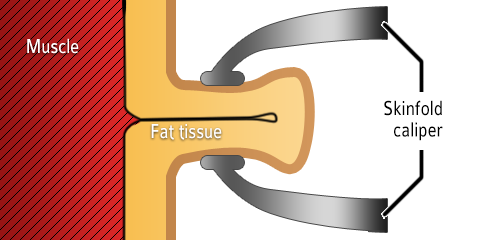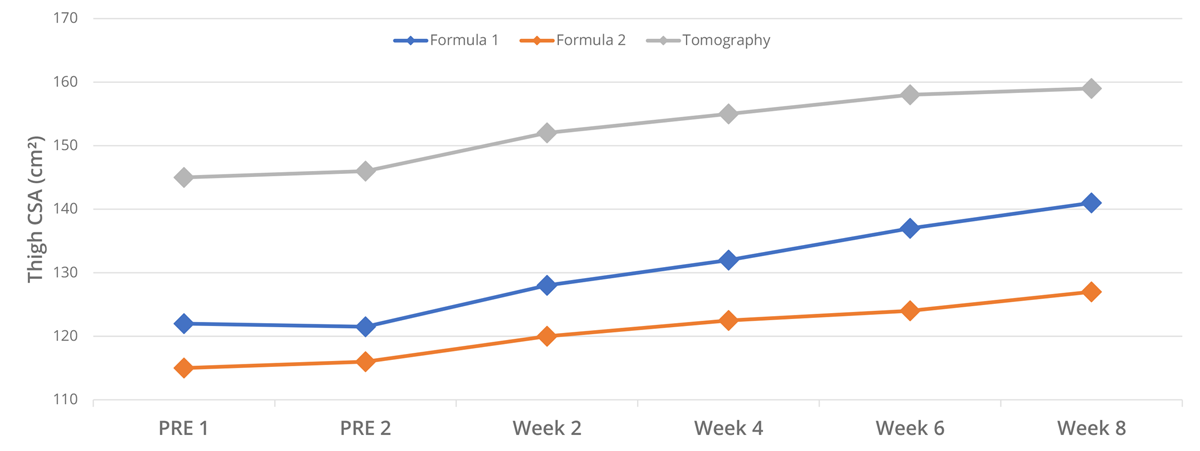
Resistance training is a tool for optimizing performance in many sports. Whether for strength, speed, power or explosive gain, the resistance training is a basis for any training plan with as many methods as the different objectives. When the goal is an improvement of the athlete strength, it is quite simple to quantify the progress made during a training program, simply by comparing the maximum loads moved before and after this program. This does not require any special tools.

Figure 1. Measurement of the thickness of the subcutaneous adipose tissue using a skinfold caliper.
However, when it comes to assess possible anthropometric changes (eg, muscle mass, body fat, etc.) that may result from this type of training, different types of equipment are needed. For an accurate estimate of body mass and muscle mass, there are several very expensive solutions such as medical imaging techniques (eg, MRI, DEXA, etc.) and much more affordable field methods, such as impedancemetry or the skinfolds measurement. Measuring skin folds requires a caliper (Fig. 1) that pinches certain sites on the body to measure the amount of subcutaneous adipose tissue. Using formulas, it is then possible to obtain an approximation of the percentage of total body fat.
If properly used, this field tool can be used to monitor with great sensitivity and accuracy the evolution of the overall body composition of athletes, but also local. For more than 30 years, researchers have developed methods based on anthropometric data to evaluate the cross-sectional area (CSA, in cm2) of the lower (Fig. 2) and upper (Fig. 3) limbs. For coaches, trainers, or athletes, these field methods would quantify the gains or losses of muscle mass in the arms and thighs. However, it is important to know the reliability of such formulas compared to medical imaging techniques and whether they are sensitive enough to detect CSA changes during a hypertrophy cycle.
In 2010, a team of American researchers1 from the University of Oklahoma, USA, tested the validity of two formulas based on anthropometric measurements from the scientific literature to determine the CSA (Formulas 1 and 2) of the thigh by comparing the results with those obtained with computer tomography in 25 men. The measurements were made midway between the lateral epicondyle and the greater trochanter. The necessary measures included the thigh circumference (circumference, in cm) and the anterior, lateral, medial and posterior thigh skinfolds.


In addition to these comparative tests, these researchers submitted the 25 participants to a weight training of 3 days a week for 8 weeks. Each training was 48 hours apart. The training consisted of 3 exercises (bench press, thigh press and leg extension). For each exercise, the participants performed 3 sets of 8 to 12 repetitions, with a rest of 2 minutes between the sets. Anthropometric measurements were taken before, every two weeks and after 8 weeks of training. Statistical tests were then carried out to compare the different methods with each other, as well as to test the sensitivity of each method during the follow-up of the training.
The results of the CSA measurements of the thigh in the 25 participants during the 8 weeks of training are presented in Fig. 4. Statistical tests show that the 3 measurement methods can be used to evaluate CSA changes at each assessment. The 3 types of measurement are nevertheless significantly different, even if they evolve in the same way.

Figure 4. Measurement of the muscle cross-sectional area as function of two formulas and computer tomography.
Both formulas are strongly correlated with tomography (r = 0.91 for formula (1) and r = 0.95 for formula (2)), although the difference between the 3 measurements is significant. This means that although there is a measurement error between the field methods and the reference method (i.e., tomography), this error is constant over time. So you can use these methods to manage lower limb muscle development over time and according to the training programs, keeping in mind that the numbers you will have are just references, not the actual reality.
Although formula (2) underestimates the muscular area of the thigh, it seems to be better correlated with tomography than formula (1). This can be explained by the fact that the formula (2) is based on the M.R.I., while the formula (1) is a geometrical estimation. It is important to note that formula (1) was used initially to evaluate the muscle section area of the arm.
Requiring only a few materials and a little experience, these methods of evaluation of the muscular section area based on anthropometric data can be used very simply in the field by the physical trainers and the coaches during the follow-up of their customers. These results can help to better understand the evolution of body composition as a function of training. And they really rationalize the gains obtained during training.
The necessary equipment is as follows :
Here are other formulas that work on the same principle. Formula (3) is a formula established and validated with respect to M.R.I. which makes it possible to determine the CSA of the thigh2. In addition to the circumference and the anterior fold of the thigh, this formula takes into account the distance between the femoral epicondyles (dE, in cm), and thus the thigh bone structure according to the individuals. The results obtained with this formula are strongly correlated with M.R.I. (r = 0.96). This formula is particularly suitable for active, young and healthy women and men :

The last two formulas were developed in 19823 specifically for the arms and validated using tomography. Both formulas are suitable for young and healthy men and women. They allow an approximation of about 8% of the muscle cross-sectional area of the arm compared to tomography :


We remind you that you can quote articles by limiting your quotation to 200 words maximum and you must include a nominative link to this one. Any other use, especially copying in full on forum, website or any other content, is strictly prohibited. In doubt, contact us.
Copyright © 2011-2024 - www.sci-sport.com - All rights reserved